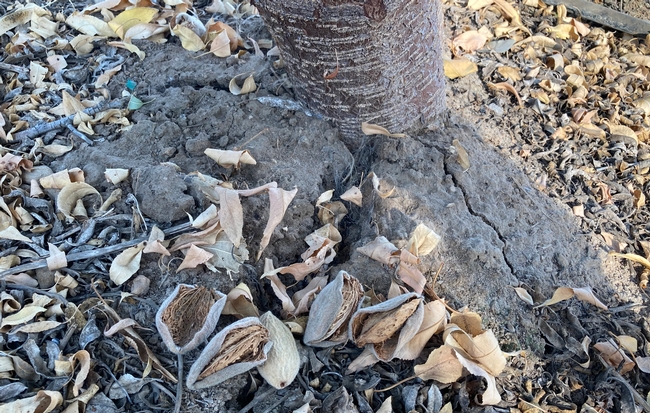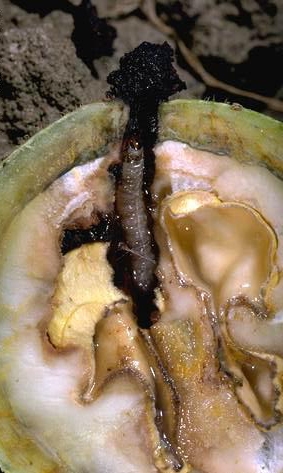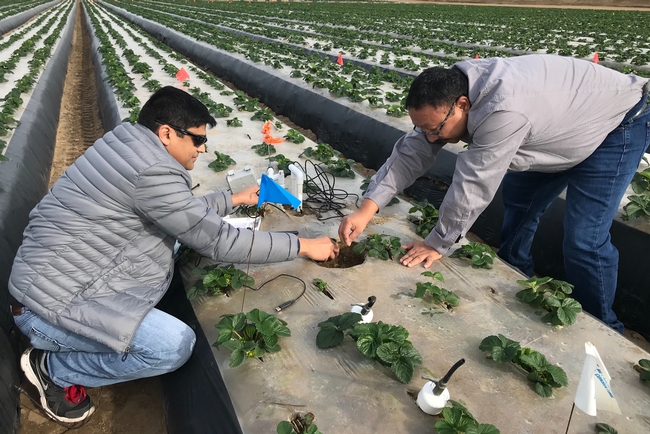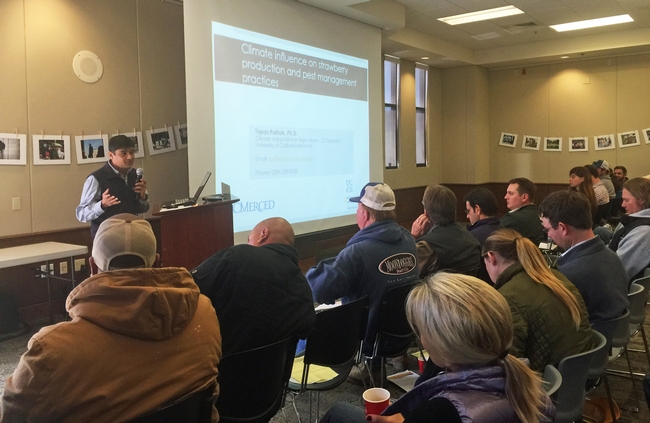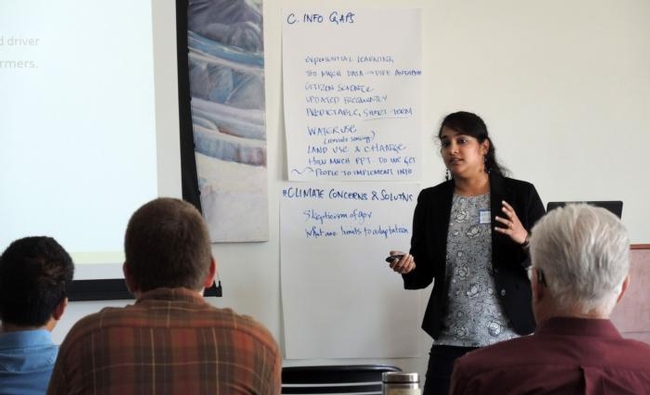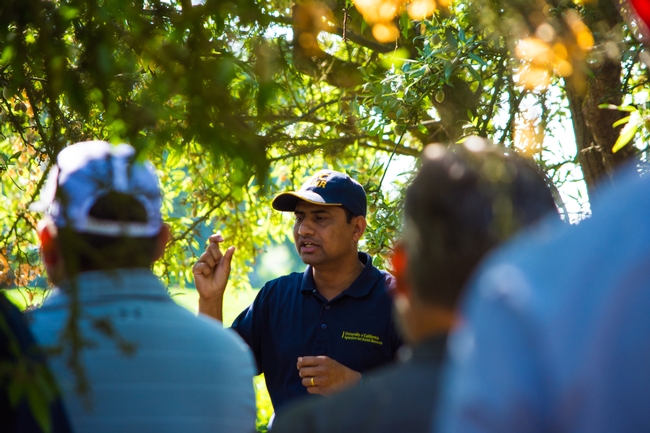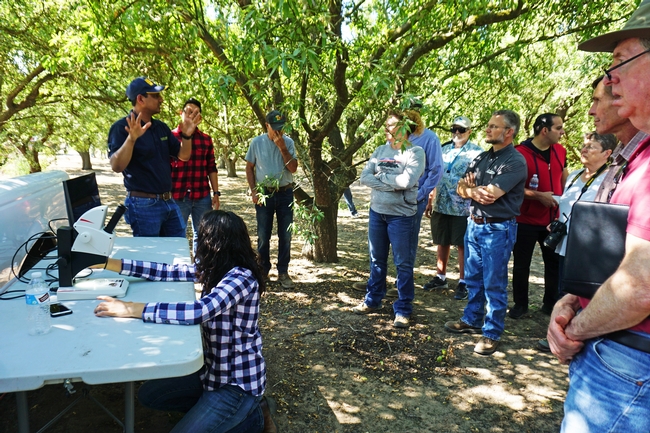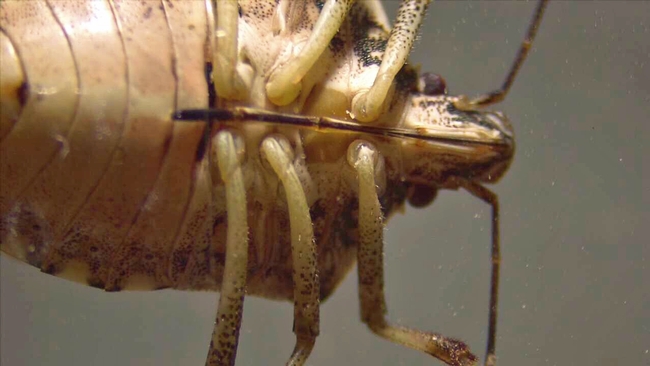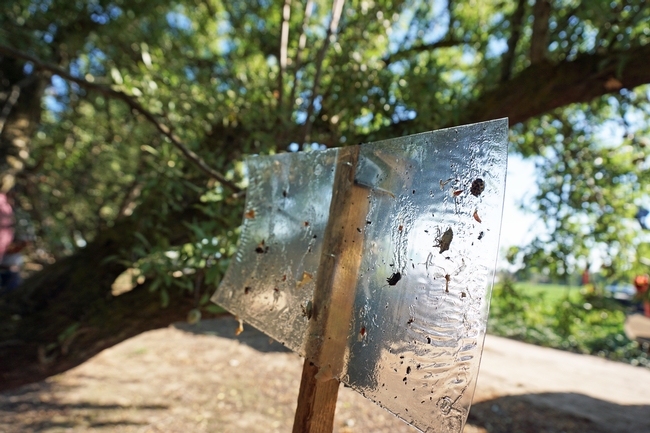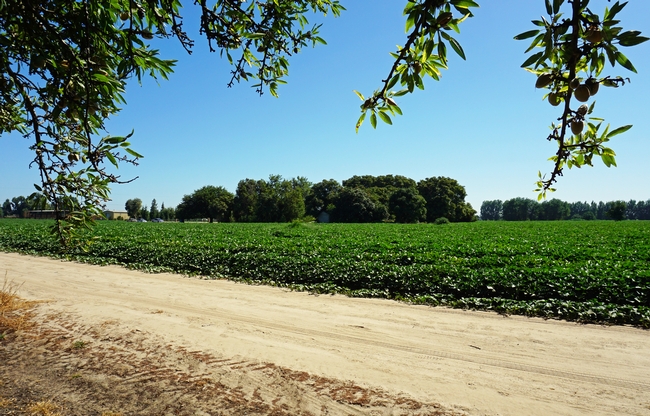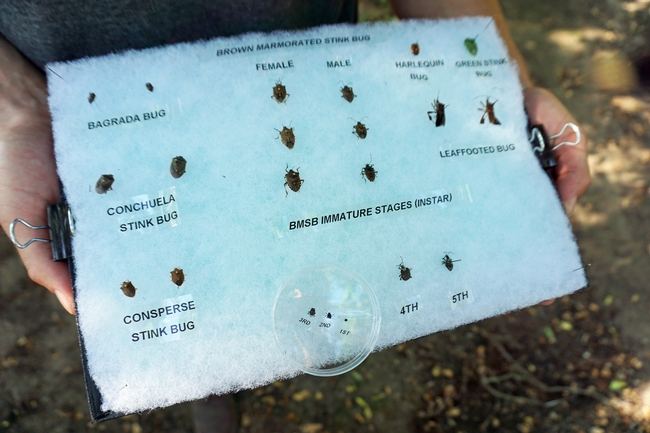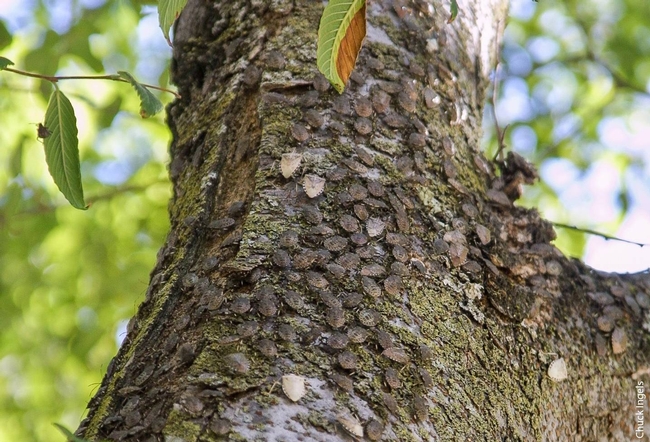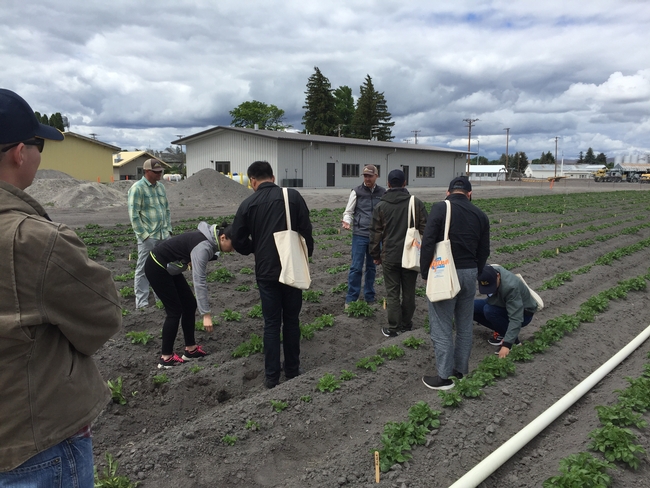Posts Tagged: Jhalendra Rijal
A hike in navel orangeworm pressure expected later this century due to climate change
Outsized wildfires, rising sea levels and disappearing glaciers are dramatic signs of climate change, but not the only ones. New UC Agriculture and Natural Resources research provides forewarning of a change that will be economically and environmentally costly to California – a fifth generation of navel orangeworm, the most destructive pest of almonds, walnuts and pistachios.
Navel orangeworm (NOW) will be more problematic in the future because of warming temperatures, UC Cooperative Extension scientists report in Science of the Total Environment.
Like most insects,NOW's development rate, physiology, behavior and reproduction are highly dependent on the ambient temperature. When the weather warms in the spring, NOW moths emerge from the nuts left in the tree or on the ground during the winter. After mating, females then recycle those last year's nuts to lay eggs and complete one generation. Adults emerged from that first and subsequent generations then lay eggs on in-season hull-splitalmondnuts, where larvae feeding damages the crop. Typically the pests fly three to four times per year – with more flights in areas with warmer weather.
“Warmer temperatures can result in early activity of the pests in the spring and increased activity during the season,” said Tapan Pathak, the UC Cooperative Extension climate change specialist and the study's principle investigator.
The scientists looked at 10 climate models to determine what nut farmers can expect to face over the next 80 years and applied NOW developmental models to the changing climate. Daily maximum and minimum temperature data were obtained for 1950 to 2005, and future projections stretched to 2100.
“The fifth generation can happen in the next few decades,” said Jhalendra Rijal, UC integrated pest management advisor and co-author of the research. “The climate models suggest that spring will begin earlier. That causes insect activity to start earlier. With increased temperatures through the season, the number of days to complete a generation is less. At the end of 2050 or so, we'll see an extra generation.”
The study focused on 23 counties in the Central Valley, from Shasta County in the north to Kern County in the south, where 1.78 million bearing acres of nut crops are planted. About two-thirds of that acreage is planted to almonds, 20% in walnuts and 16% in pistachios. The tree nut crops were valued at more than $8 billion combined in 2018, according to the California Department of Food and Agriculture.
The completion of the NOW life cycle is faster in pistachio compared to almonds and walnuts, so the potential risk of crop damage and economic loss is higher in pistachio, according to the research report. There are only a few years historically in which the models detected the fifth generation of NOW in Kern County pistachios. The occurrence of the fifth generation in almonds and walnuts was historically nonexistent, but it starts appearing in three southern counties by 2040 and eleven counties by 2100.
“In order to alleviate some of the risks related to navel orangeworm damage to nut crops, it is important to implement integrated pest management practices,” Pathak said.
IPM preventative and control measures include sanitizing the orchard during the winter by removing all the nuts on the ground and in the trees, applying synthetic reproductive hormones to limit the pests' ability to find mates, encouraging natural enemies, judicious of least-toxic pesticides if necessary and harvesting the crop early to avoid a new generation of the pest.
“A better understanding of future navel orangeworm pressure on California's major nut crops can help facilitate and strategize integrated pest management practices in order to minimize production risks,” Pathak said.
The results of the research can also inform growers and pest control advisers about the potential increased threat from other pests as the climate changes.
New $1 million research project to test mating disruption for pest control in walnuts
The Community Alliance with Family Farmers and UC Cooperative Extension are working with farmers to establish six demonstration sites in walnut orchards that will examine the effectiveness of mating disruption to control two major pests of the crop – codling moth and navel orangeworm.
The three-year research effort is funded with a $1 million award from the California Department of Agriculture Biologically Integrated Farming Systems program.
“The project sites will be in the Sacramento and northern San Joaquin Valleys, but we expect the demonstration to be of interest to walnut farmers across the state,” said Sara Tiffany, CAFF director of ecological farming and the project lead. “Farmers who grow related crops, like almonds and pistachios, will also be able to benefit from the findings.”
Over the past 55 years, conventional walnut farmers have often turned to the broad-spectrum pesticide chlorpyrifos – commonly known by the trade name Lorsban – to protect the crop from codling moths and navel orangeworm. However, California regulators have determined it may no longer be used in the state as of Dec. 31, 2020.
“Farmers need alternatives. In this project, we will be studying the effectiveness of alternatives that already exist,” said Jhalendra Rijal, UC Cooperative Extension integrated pest management advisor for San Joaquin, Stanislaus and Merced counties, the lead scientist on the project. The California Walnut Board is also part of the project team.
Six farmers will be recruited to enroll at least 80 acres each in the demonstrations – three farmers in the Sacramento Valley and three in the northern San Joaquin Valley. The entire acreage will be managed following UC IPM guidelines for walnut production, including cover crops, reduced risk pesticide options and biological control.
Forty acres will be treated with commercially available mating disruption products, while the other 40 acres will not. The treatment works by confusing the pests. Codling moth and navel orangeworm moths naturally release pheromones that help them find mates. The female lays eggs in the immature nuts, and when they hatch, the larvae feed on the nuts, rendering them unmarketable. In the treated area, the orchards will be flooded with a synthetic pheromone that makes it much more difficult for male and female pests to hone in on one another.
Besides codling moth and navel orangeworm, the project will systematically look at the effects of cover crops and predatory mite release on pest mite populations, and improvement in other natural enemy populations in walnut orchards.
The results of the IPM practices will be shared widely with growers, pest control advisors and certified crop consultants in articles, meetings and field days.
“Currently the use of mating disruption in walnuts is significantly lower than in almonds,” said Rijal, who is also the associate director for Agricultural IPM with the UC Statewide IPM Program. “We believe when farmers see the results of using mating disruption, along with other sustainable walnut production practices, we will improve the adoption rate.”
Climate-change research provides tools for farmers to adapt
This is one of a series of stories featuring a sampling of UC ANR academics whose work exemplifies the public value UC ANR brings to California.
Farmers are already seeing the effects of warmer winter nights and hotter summer days on their crops. Climate change is gradual, but increasing overall temperatures affect many aspects of farming, including where and how crops are grown. Tapan Pathak, University of California Cooperative Extension specialist based at UC Merced, is doing applied research that farmers and ranchers can use to adapt to new conditions created by a variable and changing climate.
“You don't have to shift your practice tomorrow, but if you are thinking of making a 30-year investment, it's important to know what risks there are for planting different crops,” said Pathak, who is based in the Sierra Nevada Research Institute at UC Merced.
Pathak co-chairs the UC Cooperative Extension Climate Change Program Team, whose mission is to increase the capacity among UCCE academics to address climate change concerns with science-based information. Pathak also collaborates with extension professionals from across the western U.S. to do extension events related to climate change adaptation. He works closely with state and federal agencies statewide and growers to identify changes occurring as a result of climate change that affect agriculture. Pathak's research will inform growers' decisions, such as crop variety, planting and harvest dates, extreme heat and frost protection and pest management.
“We are seeing impacts of climate change, that's evident. We have some solutions that are available, but we also need to do more locally relevant crop specific research to make agriculture resilient to climate risks,” Pathak said.
The UCCE scientist was the lead author on an important paper that synthesized the impacts of climate change on California agriculture and offers directions for future research and implementation. The authors concluded that almost all of California's crops, collectively valued at more than $50 billion a year, will be endangered to some degree by rising temperatures and variable weather patterns. The study “Climate Change Trends and Impacts on California Agriculture” was published in Agronomy in 2018.
“I think there's a lot of solutions available and there is also a clear need for adaptation research that include growers' perspectives,” said Pathak, who received a Climate Leadership Award for research from the California Climate & Agriculture Network.
Pathak is also collaborating very closely with UC Davis-based UCCE specialist Daniele Zaccaria, who is leading an international project on evaluating bioclimatic indices and developing the index that is more relevant to irrigated agriculture, which includes scientists from the U.S., Italy, Brazil and Chile.
“A bioclimatic index specific to irrigated agriculture can provide more accurate and valuable agricultural drought information that could be helpful for water resources planning and management decisions,” Pathak said.
Cal AgroClimate
Pathak is developing a web-based decision support system called Cal AgroClimate to help growers make decisions, in partnership with the USDA California Climate Hub director Steven Ostoja. It is being built on the same platform as AgroClimate, which is popular with growers in the Southeast.
Cal AgroClimate translates historical climate data and future projections into a useful decision support system for growers. For example, growers can get extreme heat and frost advisories for the next 10 to 14 days in their region and relevant resources to mitigate risks for their selected crop. It is in the early phase of development and will include a suite of tools based on the needs and priorities identified by UCCE colleagues, growers and the agricultural community in general.
In addition to his work on Cal AgroClimate, Pathak has been conducting research on specific crops.
Tomatoes
In a study looking at processing tomato production in the Central Valley, Pathak and UCCE advisor Scott Stoddard found that changing temperatures will likely change the tomato growing season. The scientists looked at processing tomato data starting from 1950 and projections for 2030-2040 to see how the time to maturity is changing.
“In general, the time from emergence to maturity, the timeframe for processing tomatoes in that region is going to shrink by two to three weeks,” said Pathak. “A lot of processors have their timeline for when they need the tomatoes for processing and so when you have this shift in the phenology, that alters the timeframe for when they mature and are ready for the processors. So, there's a whole shift in the management that growers might have to think about in the future.”
Almonds
To identify the climate information almond growers need to take adaptation action, UC Berkeley postdoctoral researcher Kripa Jagannathan, former UCCE advisor David Doll and Pathak interviewed almond growers in the Central Valley. During their conversations with farmers, the researchers clarified that long-term climate projections are not seasonal forecasts or weather forecasts for the next 20 to 30 years. The projections provide information on trends or potential of shifts from historical conditions for making long-term planning decisions.
Pest control is one area where growers will need to make changes. Research by UCCE advisor Jhalendra Rijal and Pathak shows the almond pest navel orangeworm is already extending its life to a fifth generation during a season.
Strawberries
For strawberries, Pathak, UCCE entomology and biologicals advisor Surendra Dara and postdoctoral researcher Mahesh Maskey have developed a model to forecast weekly crop yields based on weather data. “The model was pretty accurate for the Santa Maria region,” Pathak said. “A crop-specific model can be used for labor management not just crop management.”
Because California produces more than 400 agricultural products, adapting to climate change will be more complex than in other states.
UCCE advisor addresses severe brown marmorated stink bug damage in Turlock orchard
Last May, a Turlock almond grower noticed nearly all the nuts on a row of trees in his orchard had fallen to the ground.
“It looked like we shook this row,” he said. “I was scared. I thought the whole orchard was going to go.”
He called UC Cooperative Extension.
UCCE Integrated Pest Management advisor Jhalendra Rijal, who serves Stanislaus, San Joaquin and Merced counties, determined the cause was an infestation of brown marmorated stink bug (BMSB), an invasive pest from Asia. For years, BMSB had only been found in urban areas of California – most notably a 2013 infestation in midtown Sacramento.
With few natural predators and a wide host range – including apples, pears, cherries, corn, tomatoes, grapes and a variety of landscape trees – the population eventually moved into agricultural areas, first appearing in crops in 2016 in Stanislaus County. Rijal has been doing BMSB research since then.
Rijal hosted a gathering of farmers and pest control advisers Aug. 13, 2019, in the Turlock almond orchard to give them a first-hand view of the pest and the problems it causes.
BMSB are hard to find in orchards. They lay greenish colored eggs on the underside of leaves, typically in a cluster of 28 eggs. The majority of damage is caused by adults, which sting the hull with a needle-like mouth part to get to the nut. The sting can even penetrate the almond's hard shell when the fruit is mature.
Globs of clear sticky sap appear on the damaged almond hulls, typically indicating nut loss inside. Early season (March-April) infestation leads to the most severe yield loss when the nuts drop to the ground. The best way to confirm the damage is caused by BMSB is to use a trap.
“I recommend growers and pest control advisors put BMSB traps in orchard edges if they suspect BMSB damage or if the orchard is located near potential overwintering structures or host crops,” Rijal said. “BMSB are good flyers and active throughout the season, damaging nuts from April through the fall. But the most substantial damage happens in the spring through early summer."
If the orchard is close to BMSB-favored host plants, more damage is seen. A particularly troublesome neighbor plant is tree-of-heaven.
“Tree-of-heaven is a magnet for BMSB,” Rijal said, pointing to an abandoned farmhouse site on an adjacent property. “Tree-of-heaven has a nice fruiting structure that can support a lot of BMSB.”
Also an Asia native, tree-of-heaven was brought to California by Chinese immigrants during the Gold Rush. The roots, leaves and bark are used in traditional Chinese medicine. But its rapid growth and ability to clone itself to develop thick groves make it a noxious weed.
BMSB isn't a serious pest in its homeland because it is controlled by a natural enemy. Charles Pickett, the California Department of Food and Agriculture biological control scientist, shared a mounted sample of a Samurai wasp from Asia, Trissolcas japonicus, which lays its eggs in BMSB eggs.
“The parasite attacks most of the eggs in the field in eastern Asia,” Pickett said. “It's our goal to release the wasp in California. We first need a special permit to make sure it won't harm our environment and doesn't attack any beneficial stink bugs.”
The Samurai wasp has already found its own way to some BMSB infestation sites in the Eastern U.S. and in Los Angeles.
“We hope to someday release the parasitic wasp,” Pickett said. “It won't eradicate BMSB, but it will help.”
June 2018 news clips
Agricultural advances draw opposition that blunts innovation
(Science) Anne Q. Hoy, June 29
Scientists are using technology to expand global food production and ease its environmental impact, but advances are being challenged by claims that lack scientific evidence and raise public distrust and concern, a leading agricultural scientist told an American Association for the Advancement of Science audience.
Alison Van Eenennaam traced the advent of campaigns against agricultural innovations related to areas from cattle and chicken production systems to plant biotechnology. The impact such efforts are having on agricultural advances was the focus of the ninth annual AAAS Charles Valentine Riley Memorial Lecture on 5 June at the AAAS headquarters in Washington, D.C.
http://science.sciencemag.org/content/360/6396/1413.full
UC Davis Experts Help Farmers, Ranchers Profit in Growing Trend
(Cal Ag Today) Patrick Cavanaugh, June 29
Many farmers could benefit from agritourism and the added value it brings, but developing successful agritourism operations can be tricky. Experts at the Agricultural Sustainability Institute (ASI) at UC Davis are helping farmers and others in the agricultural community understand the regulations, permits, insurance, marketing and other considerations needed to succeed.
“Agritourism operations are more successful when they're part of a supportive community of tourism professionals, county regulators, agriculture regulations and others,” says Gail Feenstra, ASI's food, and society coordinator.
Feenstra and her team recently received a $73,000 grant from Western Sustainable Agriculture Research and Education, a U.S. Department of Agriculture program, to develop training, resources and peer support for farmers and ranchers considering agritourism. Feenstra is working with Penny Leff, ASI's statewide agritourism coordinator and team project manager.
https://californiaagtoday.com/agritourism-california/
Green thumbs at the Marin County Fair
Wendy Irving, June 29
…UC Marin master gardeners is a group of more than 300 trained volunteers who work as non-paid staff members of the University of California Cooperative Extension. There are master gardener programs in 50 counties across California; our Marin group is one of the largest and most active.
http://www.marinij.com/article/NO/20180629/FEATURES/180629808
Answer to how urban coyotes thrive is not for weak-stomached
(Texarkana Gazette) From the LA Times, June 29
This scientific study is a coyote postmortem on an unprecedented scale—it has so far documented the contents of 104 stomachs and intends to examine 300 by the end of the year. The team, led by Niamh Quinn, UC Cooperative Extension's human-wildlife interactions advisor, is already generating a wealth of data to better understand how these omnivorous canids sample everything from pocket gophers to hiking boots while managing to survive in a land of 20 million people.
Mechanized vineyard saves labor, boosts quality
(Western Farm Press) Tim Hearden, June 27
Kaan Kurtural started working on a fully mechanized vineyard to help growers save on labor costs, but then he noticed it also produced grapes with superior quality.
“We made wine from these last year and compared it to our traditionally-farmed vineyards,” says Kurtural, a specialist in the University of California-Davis Department of Viticulture and Enology. “Until we tell people what it is, they can't distinguish the quality of the fruit or the wine.”
He demonstrated the 40-acre experimental vineyard during a recent field day at the UC-Davis Oakville Station north of Napa. About 200 winegrape growers, vineyard consultants, and other industry representatives attended.
http://www.westernfarmpress.com/grapes/mechanized-vineyard-saves-labor-boosts-quality
Several methods available to control vineyard weeds
(Western Farm Press) Tim Hearden, June 27
As most fumigants in California are being phased out, growers are having to find other ways to control weeds in young vineyards.
And while weeding by hand has been done, increased costs and a shrinking labor force have made this task impractical, says John Roncoroni, University of California Cooperative Extension Weed Science Farm Advisor in Napa County.
http://www.westernfarmpress.com/grapes/several-methods-available-control-vineyard-weeds
New podcast offers advice to California farmers
(Capital Press) Padma Naggapan, June 26
Two enterprising farm advisors with the University of California's cooperative extension have begun a podcast that will focus on tree crops and other produce grown in the Central Valley.
Called “Growing the Valley,” the podcast will have a new episode every two weeks, with each episode focused on news growers can use, such as managing specific pests, irrigation techniques, alerts about what to watch out for, and what tasks to take care of at particular times of the year.
http://www.capitalpress.com/Research/20180626/new-podcast-offers-advice-to-california-farmers
Proactive Pawnee Fire response in Lake County seeks to avoid another catastrophe
(SF Chronicle) Lizzie Johnson, June 25
“I've never seen so much focused attention in Sacramento on the issue,” said Keith Gilless, a professor of forest economics and dean of the College of Natural Resources at UC Berkeley.
“Last year, 2017, got everybody's attention,” said Gilless, chair of the California State Board of Forestry and Fire Protection. “Last year was just terrible. Everybody involved is doing their best to be as prepared as we can. Any area might burn now, including those with much higher structure densities than they did 20 or 50 years ago.
“You are going to need a lot of resources that you might not have needed before,” he said. “The state is being very aggressive in its suppression efforts.”
UC's Humiston welcomes visiting Chinese ag scientists
(Farm Press) Jeannette Warnert, June 25
UC Agriculture and Natural Resources vice president Glenda Humiston recently welcomed a delegation of Chinese agricultural scientists to UC ANR's Intermountain Research and Extension Center in Tulelake, reported Danielle Jester in the Siskiyou Daily News.
http://www.westernfarmpress.com/extension/ucs-humiston-welcomes-visiting-chinese-ag-students
With vineyard labor scarce, Napa growers warm up to machines
(Napa Valley Register) Henry Lutz, June 24
On a recent morning at the UC Davis Oakville Experimental Station, extension specialist Dr. Kaan Kurtural walked along the edge of an especially tall block of Cabernet Sauvignon.
Planted in 2016, the block hosts 1,340 vines and produces roughly 15 to 18 pounds of fruit per vine. “So it'll be yielding quite nice,” Kurtural said as he walked down the 62-inch tall rows.
Far more notable than the vineyard's fruit, however, is how it gets farmed.
“There are no hand practices out here,” said Kurtural. “Everything is done by machine.”
Early Detection Key to Managing Ceratocystis Canker in Almonds
(Growing Produce) Dianne Munson, June 22
...Based on a statewide survey out of the Department of Pathology at University of California, Davis, canker diseases are the primary cause of tree death in almond orchards, and Ceratocystis canker is one of the most prevailing canker diseases found in California. This canker disease is aggressive, but it doesn't have to mean disaster.
“If you know what to look for, the disease is manageable,” says Florent Trouillas, UC Cooperative Extension Specialist, Department of Plant Pathology, University of California, Davis.
California has 27M more dead trees than in 2016, but numbers may be easing in some areas
(Ventura County Star) Cheri Carlson, June 22
“Trees aren't getting moisture that they need to be healthy and they're stressed,” said Susan Kocher, a natural resources adviser for UC Cooperative Extension. “We had a huge insect outbreak because of the drought.”
Kocher, based in South Lake Tahoe, focuses on the Central Sierra, where stands of ponderosa pines were hit hard by beetle attacks.
…The highest risk of fire is when trees still have their needles – the so-called “red and dead” phase, Kocher said. Green needles turn red, and those dried-out needles are a particularly flashy fuel, like tinder in a campfire. Once the needles fall off, the risk drops a bit.
Chinese scientists visit Tulelake
(Siskiyou Daily News) Danielle Jester, June 20
The University of California Agriculture and Natural Resources Intermountain Research and Extension Center in Tulelake hosted a group of scientists from Chinese universities on Sunday; the scientists are on a tour of agriculture in northern California through June 22.
University of California Vice President of Agriculture and Natural Resources Glenda Humiston explained the purpose of the tour, noting, “The Chinese face many of the same issues that we do here in the U.S. The Chinese universities want to improve rural economic development to lift up the quality of life for people in rural communities.
“They are also responding to global climate change, drought and pests while trying to improve food security and water use efficiency. They see UC Cooperative Extension as an effective research model; we hope that scientific collaborations will accelerate solutions and help maintain relations for California agriculture with China.”
http://www.siskiyoudaily.com/news/20180620/chinese-scientists-visit-tulelake
It's summer. Here's how to preserve those fresh fruits and veggies
(San Luis Obispo Tribune) Rosemary Orr, June 20
June in San Luis Obispo County is a wonderful time to start preserving our summer bounty of fruits and vegetables.
The UCCE Master Food Preservers will teach the basic principles of food preservation and canning in its Introduction to Canning class on Saturday.
https://www.sanluisobispo.com/living/home-garden/article212766254.html
With wildfire season at hand, California on slightly safer footing this year
(SF Chronicle) Kurtis Alexander, June 17
… But as significant, and plentiful, as the new fire-protection measures are, they merely nip at the edge of an underlying issue: that fire is a constant in California, and as long as people choose to live in and around the state's wildlands, experts say, the threat remains.
"I would not be surprised if we have another big fire," said Bill Stewart, forestry specialist at the University of California, Berkeley. "I just don't think we're where we need to be."
… “We really haven't put together the pieces of a resilient fire strategy in local areas,” Stewart said.
https://www.sfchronicle.com/news/article/With-wildfire-season-at-hand-state-on-slightly-13000782.php
Reducing food waste to combat world hunger
(Morning Ag Clips) June 17
One-third of the world's food is spoiled or tossed rather than eaten, a fact that is tragic when nearly one billion people go hungry. The injustice of food waste is worsened by the fact that food decomposing in landfills emits greenhouse gases that contribute to climate change.
UC Cooperative Extension is working closely with the cities and county of Santa Clara in a far-reaching program to divert organic matter – food and green waste – from landfills by composting and using the product to enrich soil in the home garden.
https://www.morningagclips.com/reducing-food-waste-to-combat-world-hunger/
From dendrometers to drones, devices drive ag-tech boom
(Farm Press) Tim Hearden, June 16
Agriculture across the country is going high-tech, and California is leading the way as the tree nut and other industries are looking for ways to save water.
Agriculture across the country is going high-tech, as the ag and food sectors invested $10.1 billion in digital technologies in 2017, according to a University of California study. That's up from $3.2 billion in 2016, reports the UC's Giannini Foundation for Agricultural Economics.
In California, which was the leading state last year with $2.2 billion spent to adopt new technologies in ag and food production, UC Cooperative Extension researchers are researching or developing lots of new, innovative ideas. And growers are putting them to work in their fields and orchards.
http://www.westernfarmpress.com/technology/dendrometers-drones-devices-drive-ag-tech-boom
Santa Barbara County Avocado Farmer Struggles to Find Workers Amid Immigration Crackdown
(CNN Money/KTLA) Kristen Holmes, June 15
…“The crops that are most affected are the ones that use hired labor,” explains Daniel Sumner, director of the University of California, Agricultural Issues Center at UC Davis, pointing to avocados, berries and tree fruits. “It's really now through the rest of the summer that we're going to hear more and more farmers and farm workers rushing to get a harvest in with really not enough labor force to do it. And that's a real challenge. It may mean that we have crops rotting in the fields.”
http://money.cnn.com/2018/06/15/news/economy/california-farmer-workers-immigration/index.html
http://ktla.com/2018/06/15/santa-barbara-county-avocado-farmer-struggles-to-find-workers-amid-immigration-crackdown/amp
Research Nets Going Over Citrus Trees To Prevent Huanglongbing Disease
(Cal Ag Today) Jessica Theisman, June 15
Beth Grafton-Cardwell is the director of the Lindcove Research Extension Center in Tulare County and research entomologist based out of the University of California, Riverside. She recently told California Ag Today that there is work being done on installing a net structure to protect trees from Asian Citrus Psyllids, which spread the deadly Huanglongbing disease. Texas A&M researchers are installing net structures on the edge of groves to block psyllids from coming into an orchard.
https://californiaagtoday.com/research-nets-going-citrus-trees-prevent-huanglongbing-disease/
Overburdened growers fuel an ag-tech investment boom
(Western Farm Press) Tim Hearden, June 14
…While ag was slower than some other industries at adopting digital technologies, farm and food sector investments in these technologies zoomed to $10.1 billion nationwide last year, up from $3.2 billion in 2016, according to a new University of California report.
California was the leading state for ag-tech investments with $2.2 billion in 2017, or 22 percent of the total, and ag and food producers in the Golden State spent $5.1 billion on new technologies between 2012 and 2017, reports the UC Giannini Foundation for Agricultural Economics.
http://www.westernfarmpress.com/technology/overburdened-growers-fuel-ag-tech-investment-boom
UCD Oakville Field Day Highlights: Trellis Trials, Red Blotch Vector Update, Mechanization Tools
(Wine Business) Ted Rieger, June 12
The University of California, Davis (UCD) hosted its annual Grape Day at the Oakville Station experimental vineyard in Napa Valley June 6 with talks and presentations by UC Cooperative Extension specialists, and presentations and equipment demos from vineyard industry suppliers.
UCD viticulture extension specialist Dr. Kaan Kurtural showed a trial planted in 2016 with six different trellis systems designed for mechanical harvest in a 1-acre block at the experimental vineyard using Cabernet Sauvignon 08 on 3309 rootstock. The six trellis types include: a traditional vertical-shoot- positioned (VSP) trellis as a control; a single high-wire system designed for mechanized management; a high-quad system; a cane-pruned system with 12-inch cross arms for a sprawl-type canopy; and two versions of a relaxed VSP, one with a T-top post for a wider canopy.
https://www.winebusiness.com/news/?go=getArticle&dataId=199959
Local groups offer water measurement course
(Siskiyou Daily News) June 12
The Siskiyou County Cattlemen, Siskiyou County Farm Bureau and University of California, Cooperative Extension will sponsor a Water Measurement and Reporting Course in order to comply with Senate Bill 88.
http://www.siskiyoudaily.com/news/20180612/local-groups-offer-water-measurement-course
New Potato Varieties Displayed at Field Day in Kern County
(AgNet West) Brian German, June 11
Dozens of industry professionals took part in the annual Kern County Potato Variety Field Day where attendees got an opportunity to view new potato varieties and see the progress of ongoing growing trials.
“The potato field day in Kern County has a long history, it's been going on for generations essentially,” said Farm Advisor Emeritus with Kern County Cooperative Extension Joe Nunez. “It's an opportunity for the growers to see all the new varieties that are being developed throughout the country and see how they perform here in Kern County because our growing conditions here are a little bit different than where most of the potato varieties are being developed.”
http://agnetwest.com/new-potato-varieties-field-day-kern-county/
Debating California Tillage
(Farm Equipment) Alan Stenum, June 9
Despite differing opinions, Alan Wilcox, of Wilcox Agri-Products and Jeff Mitchell, no-till advocate at University of California–Davis, sat down during World Ag Expo in Tulare, Calif., to discuss the challenges and the opportunities for conservation tillage practices to take hold in California's Central Valley.
https://www.farm-equipment.com/articles/15683-debating-california-tillage
Letter: Residents get primer on fire preparedness
(Chico Enterprise-Record) Calli-Jane DeAnda, June 8
May was wildfire awareness month and the community participated in the wildfire safety fair at Lake Oroville Visitor Center on Saturday, May 19. At this fantastic event community members were able to get information about how to sign up for emergency notifications, access the evacuation preparedness plan, get wildfire recovery information and get tips for protecting homes from wildfire.
Kate Wilkin, UC Cooperative Extension, provided two presentations on prescribed fire and ways to protect homes from wildfire. Local fire-safe councils were there to answer the question: What does a fire-safe council do?
https://www.chicoer.com/2018/06/07/letter-residents-get-primer-on-fire-preparedness/
Why a Decline in Insects Should Bug You
(Wall Street Journal) Jo Craven McGinty, June 8
Entomologists want to put a bug in your ear: Insects are necessary for the survival of mankind.
“It's the classic third-grade food chain,” said Richard Redak, an entomologist at the University of California, Riverside, and co-author of the book “Bugs Rule!” “If you pull insects out, you've got a problem.”
…“Any organic product in a human's life probably has a beneficial insect and a pesty insect,” Dr. Redak said. “The pesty ones are an incredibly small fraction of the total. Those that are not a problem are critical to the ecosystem.”
https://www.wsj.com/articles/why-a-decline-in-insects-should-bug-you-1528467502
Brown Marmorated Stink Bug Officially Deemed Pest of California Almonds
(Growing Produce) David Eddy, June 7
Brown marmorated stink bug (BMSB) is certainly not new to California growers, but in the wake of some more troubling finds, it is now officially a pest of almonds.
Almonds are now listed as a preferred host on the Stop BMSB website, which was created by a team of researchers from all over the country dedicated to finding a way to stop the pest from damaging a wide range of crops.
One of those researchers is Jhalendra Rijal, University of California Cooperative Extension Area IPM Advisor for San Joaquin, Stanislaus, and Merced counties, who said the first such damage was just two years ago, when they were found in peaches. The actual first finding in the state was three years before that, in Sacramento, but despite being a very large find, they never appeared to spread, adding to the mystery of BMSB movement.
Visible smoke coming from UC field station burn
(The Union) June 7
Nevada County residents wondering why there is smoke in the air coming from our neighbors to the west today may be seeing smoke from a live fire training held by the University of California Cooperative and Extension at a field station in Browns Valley, according to Cal Fire spokesperson Mary Eldridge.
https://www.theunion.com/news/visible-smoke-coming-from-uc-field-station-burn/
UCCE advisors launch 'Growing the Valley' podcast
(Farm Press) Jeannette Warnert, June 5
A new UC Cooperative Extension podcast that focuses on growing orchard crops in the San Joaquin and Sacramento valleys is now available free at http://growingthevalleypodcast.com, Apple iTunes and Google Play Music.
The hosts are Phoebe Gordon, UCCE orchard systems advisor in Madera and Merced counties, and Luke Milliron, UCCE orchard systems advisor for Butte, Tehama and Glenn counties. The pair conduct research and extension programs that cover tree crops, with a focus on almonds, pistachios, walnuts, prunes, figs and cling peaches.
http://www.westernfarmpress.com/extension/ucce-advisors-launch-growing-valley-podcast
7 Highlights from the 2018 World Meat Congress
(Pork) U.S. Meat Export Federation, June 4
The 2018 World Meat Congress concluded Friday with sessions focused on consumer trends and education, as well as an in-depth look at cutting-edge technologies reshaping meat production around the world. The 22nd World Meat Congress was held in Dallas May 31 and June 1. Hosted by the U.S. Meat Export Federation (USMEF) and the International Meat Secretariat (IMS), the event drew about 700 participants from more than 40 countries.
…The panel featured Gary Rodrigue, blockchain food trust leader for the IBM Corporation; Dr. Martin Wiedmann, Gellert family professor in food safety at Cornell University; and Dr. Alison Van Eenennaam, cooperative extension specialist for animal genomics and biotechnology at the University of California-Davis.
… Van Eenennaam, whose program at UC-Davis focuses on research and education around the use of animal genomics and biotechnology in livestock production systems, explained the value of gene editing. For example, research is underway to utilize gene editing to prevent such diseases as African swine fever in hogs and tuberculosis in cattle.
“What better way to approach dealing with disease than through genetic improvement?” she noted.
https://www.porkbusiness.com/article/7-highlights-2018-world-meat-congress
Use of gene editing to introduce the polled trait into elite germplasm
(Progressive Dairyman) Alison L. Van Eenennaam and Maci L. Mueller, June 4
Physical dehorning of dairy cattle is a standard practice to protect both human dairy workers and other animals from injury. However, it is not only costly for producers, but also painful and stressful for the animals. As a result, dehorning is currently facing increased public scrutiny as an animal welfare issue. Despite these factors, 94 percent of U.S. dairy cattle producers report routine dehorning.
Early Ripening Grapes Could Revolutionize Raisin Production
(Growing Produce) Matthew Fidelibus, June 2, 2018
The USDA-ARS raisin grape breeding program has long focused on the development of early ripening varieties. Early ripening allows drying to begin sooner, thus helping to avoid inclement weather and enable production of dry-on-vine (DOV) raisins. ‘Fiesta' and ‘Selma Pete' are examples of early ripening raisin grapes from the USDA that have helped change the way California raisins are made.
http://www.growingproduce.com/fruits/grapes/early-ripening-grapes-revolutionize-raisin-production

